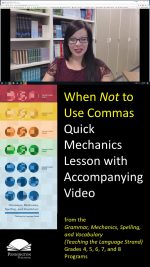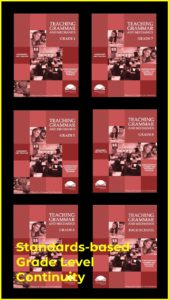When Not to Use Commas
When Not to Use Commas
Play the quick video lesson HERE and click the upper left back arrow to return to this lesson.
Common Core Language Standard 2
Commas are the most over-used punctuation. Placing a comma incorrectly is certainly more noticeable than leaving one out. So, would the best advice be “When in doubt, leave it out”? Maybe. However, it certainly is best to know both rules for proper and improper comma usage.
Today’s mechanics lesson is on when not to use commas. Remember that knowing when or where not to use punctuation is just as important as knowing when or where to use punctuation. Most writers overuse commas. Commas used in the wrong places can create confusion for the reader.
Now let’s read the mechanics lesson and study the examples.
Don’t use a comma to separate a subject from its verb. Example: Pete in Colorado, is a friend of mine. Now X-out the comma.
Also, don’t use a comma to separate a compound subjects, compound objects, or compound predicates. Examples: Pete in Iowa, and Jim in Ohio went to see Tom, and Ben. I sent a check, and mailed a card to Pete. Now X-out the commas.
Now circle or highlight what is right and revise what is wrong according to mechanics lesson.
Practice: Toby with his quick reflexes, and Bryan with his quick, powerful kick gave their smart fullbacks and talented, goal-keeper quite a match.
Let’s check the Practice Answers.
Mechanics Practice Answers: Toby with his quick reflexes and Bryan with his quick, powerful kick gave their smart fullbacks and talented goal-keeper quite a match.
Now let’s apply what we have learned.
Writing Application: Write your own sentence using a compound subject, compound predicate, and compound object.
*****

Pennington Publishing Grammar Programs
Teaching Grammar, Usage, and Mechanics (Grades 4, 5, 6, 7, 8, and High School) are full-year, traditional, grade-level grammar, usage, and mechanics programs with plenty of remedial practice to help students catch up while they keep up with grade-level standards. Twice-per-week, 30-minute, no prep lessons in print or interactive Google slides with a fun secret agent theme. Simple sentence diagrams, mentor texts, video lessons, sentence dictations. Plenty of practice in the writing context. Includes biweekly tests and a final exam.
Grammar, Usage, and Mechanics Interactive Notebook (Grades 4‒8) is a full-year, no prep interactive notebook without all the mess. Twice-per-week, 30-minute, no prep grammar, usage, and mechanics lessons, formatted in Cornell Notes with cartoon response, writing application, 3D graphic organizers (easy cut and paste foldables), and great resource links. No need to create a teacher INB for student make-up work—it’s done for you! Plus, get remedial worksheets, biweekly tests, and a final exam.
Syntax in Reading and Writing is a function-based, sentence-level syntax program, designed to build reading comprehension and increase writing sophistication. The 18 parts of speech, phrases, and clauses lessons are each leveled from basic (elementary) to advanced (middle and high school) and feature 5 lesson components (10–15 minutes each): 1. Learn It! 2. Identify It! 3. Explain It! (analysis of challenging sentences) 4. Revise It! (kernel sentences, sentence expansion, syntactic manipulation) 5. Create It! (Short writing application with the syntactic focus in different genre).
Get the Diagnostic Grammar, Usage, and Mechanics Assessments, Matrix, and Final Exam FREE Resource:
![]()





 Possessive Pronouns
Possessive Pronouns 
